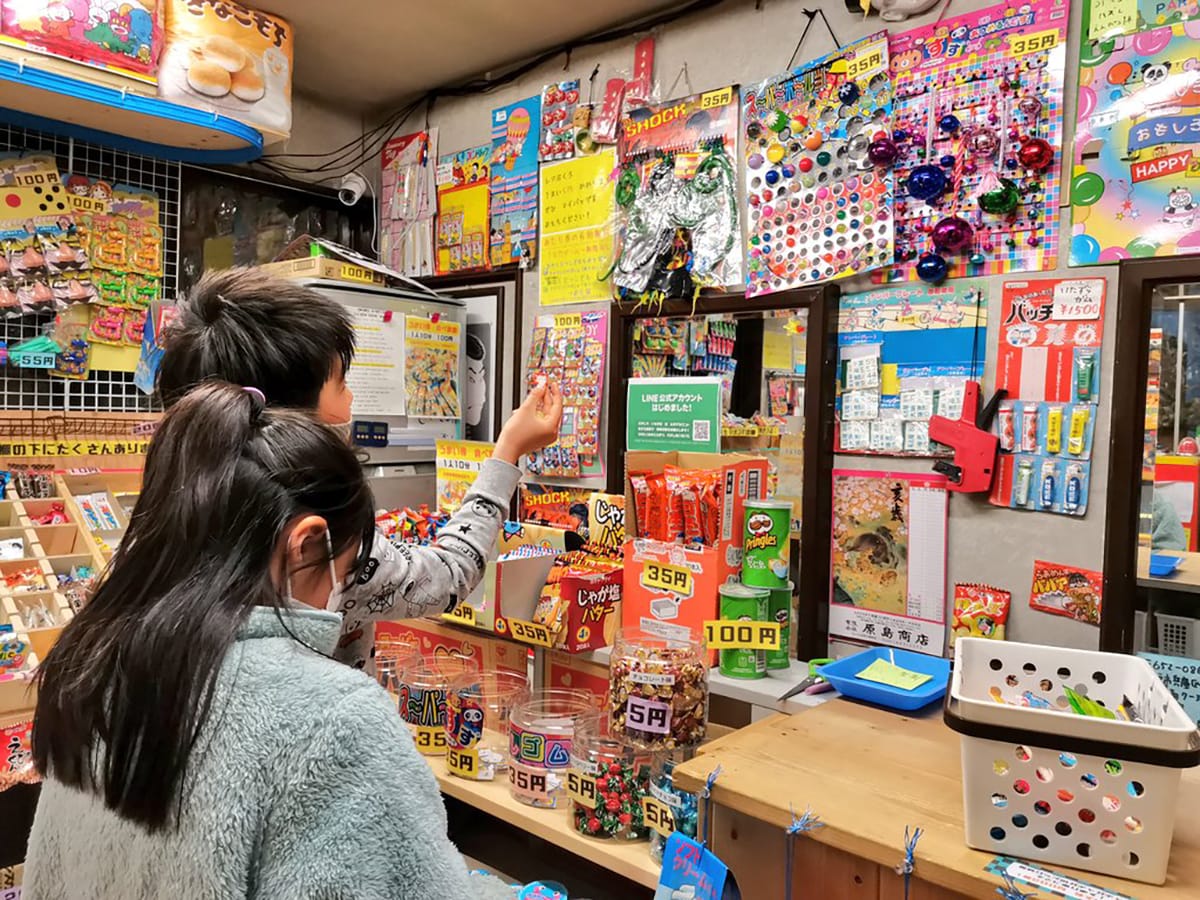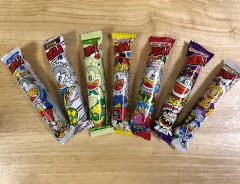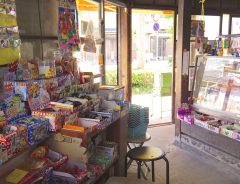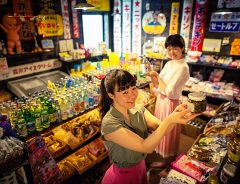
Source: Children making their selection in the Inagaki Dagashi Store. | With permission from Atsushi "Andy" Miyanaga
The current state of dagashi: What Japan is losing along with its dagashi shops [News Crossing]
- Tags:
- dagashi / News Crossing / Nozomi Matsukawa / withnews
Related Article
-

Dagashi review: We tried 7 flavors of Umaibō, Japan’s top “tasty stick” snack [News Crossing]
-

Showa retro vibes in the nostalgic Tokyo neighborhood of Shibamata: Top places to visit
-

Dagashi discoveries: Japan’s “penny snack” culture [News Crossing]
-

Try Japanese School Lunches From Meiji to Heisei Era At Retro Showa Tamagawa Onsen


By Nozomi Matsukawa 松川希実, withnews
As people's lifestyles change, nostalgic dagashi* "penny snacks" are disappearing one by one. What is the meaning of dagashi in Japan?
*Dagashi 駄菓子 are inexpensive snacks and candies geared towards children. Both the candies and the shops that sell them are slowly disappearing. (For more information, read "Dagashi discoveries: Japan’s “penny snack” culture [News Crossing]")
grape Japan and withnews [a web media operated by Asahi Shimbun] have teamed up for a joint project called "News Crossing," a new series in which writers from different nationalities and backgrounds converge on a single facet of Japanese culture or a city neighborhood to share opinions and insights.
In the first installment, we take you to a cultural crossroads exploring a variety of perspectives on the theme of dagashi.
[News Crossing] Related articles
Are you learning Japanese? You can read the original Japanese version of this article here on withnews:
Slowly disappearing
Eaerly this year, a tweet from 日本一のだがし売場 nipponichi no dagashiuriba (Japan's largest dagashi outlet) in Okayama Prefecture (@dagashi_okayama) became a hot topic.
Product discontinuation announcement
Amehama Confectionery
☞Cola candy
☞Cider candy
☞Kyoho grape candy
☞Hokkaido milk candy
☞Coffee milk candy
The company is going out of business at the end of April :( (production will continue until the end of February).
Amehama's 10 yen candies with raffles, thank you for the sweet memories...
The announcement was retweeted over 7,000 times, eliciting comments such as "Now it's this candy..." "Little by little, our childhood memories are disappearing."
Dagashi: more than just 'things'
The source of the tweet, 大町株式会社 Omachi Co. Ltd., is a confectionery wholesaler with 70 years of experience located in Setouchi City, Okayama Prefecture. They operate the largest directly managed dagashi store in Japan with a floor space of about 2,500 square meters.
Vice President 安達勇治 Yuji Adachi, responsible for the account, listed some of the previous dagashi discontinuation announcements he had made:
All of these announcements attracted a lot of attention.
At first glance, such product discontinuation announcements may seem negative.
Adachi explained his thoughts behind the tweets: "Wouldn't it be sad if a product suddenly disappeared one day? Especially with dagashi, there are people who have been buying a particular product for decades. I want to give the fans who have supported us all these years to have a chance to say goodbye."
Apparently, some people have been responding to such announcements by stockpiling and reselling. "To tell the truth, (when I Tweet) I worry that the people who really want the product won't be able to receive it," Adachi admits.
On the other hand, every time such discontinuation announcements go out, the information is retweeted along with many memories. Here a just a few:
Whenever Adachi sees a response like this, he says: "Dagashi is not just a 'thing,' it is filled with memories. That's why people need to take time to say goodbye."
Finding value in inefficiency
In Japan, dagashi products disappear every month. These snacks cost 10 to 30 yen each. Many family-run businesses and small manufacturers suddenly go out of business due to broken machinery. Even so, it's hardly noticed by anyone. Dagashi's labor costs make them unprofitable, so they are no longer displayed in supermarkets where there are many customers.
Omachi Co., Ltd., however, has been deliberately collecting and selling such items that are disappearing from shelves. One such example of their efforts is the "Mottainai Hiroba," a collection of products that were on the verge of being discarded.
As a result, they have created a unique store filled with products that you cannot find in supermarkets. Customers say things like: "I've never seen products like this before," or "It brings back memories." People continue to visit from far away, sometimes with their parents, sometimes three generations at once.
"Dagashi brings smiles to people's faces. I think we should pursue 'inefficiency' that creates excitement," says Adachi.
The "Mottainai Hiroba" at "Japan's #1 Dagashi Store." | Image used with permission from Omachi Co., Ltd.
Creating new value and promoting dagashi to the world
Dagashi are "snacks to make children happy." Due to this nature, however, makers find it difficult to raise prices. And, of course, they need to ensure that their products are safe as well. Unlike large confectionary manufacturers, dagashi manufacturers are small scale. They have been forced to make considerable efforts to keep up with the times.
In 2015, about 160 dagashi and toy manufacturers got together to launch the "DAGASHI to Make the World Smile Association" (DAGASHIで世界を笑顔にする会 dagashi de sekai wo egao ni suru kai) in an attempt to revitalize dagashi culture. The association aims to give the industry a shot in the arm by supporting small and medium-sized manufacturers in areas such as public relations, which they are often not good at.
Every year, the association celebrates March 12th as "Dagashi Day" and encourages people to "send dagashi and share a smile." For its sixth year, 120,000 pieces of candy were collected from member companies and sent to 320 kindergartens, nursery schools, elementary schools, and orphanages nationwide. They also held an online event, which is quite the opposite of dagashi's "traditional" image.
They also have their sights set beyond Japan's borders. In 2015 and 2018, they participated in the "Samurai Japon" event to introduce Japanese culture in France. Snacks and candies in the 10 to 30 yen price range are rare in France, so visitors were surprised to find cheap, tasty, and playful items such as "whistle ramune" that make a sound when blown. The dagashi were apparently quite a hit, eliciting comments such as: "What on earth is this awesome food? This is great!"
They are trying to add new value to dagashi as snacks that "bring smiles to people's faces," transcending generations and borders.
A place for children to gain social experience
But the appeal of dagashi doesn't end there.
Children stopping by the dagashi store on their way home from school, pocket money clenched in their hands... Some people are working hard to make such a scene commonplace once again in Japan.
In June 2019, the Inagaki Dagashi Shop (駄菓子屋いながき dagashiya inagaki) opened in Kazo City, Saitama Prefecture. The store's owner, Atsushi Miyanaga, who goes by the name Andy, is a rare "newcomer" to the industry, having originally worked in childcare and started a dagashi shop from scratch.
His interest in dagashi stores started when he was running a daycare center for school children. One day, he took the children on a field trip. He gave the children some pocket money and said, "Go ahead and buy whatever you want," to let them buy local snacks. However, a few of the children just stood there in a daze.
They said things like: "Teacher said 'buy whatever you want," but I don't know what I'm supposed to do" or "I don't know what 'change' is."
Many of the children had both parents working, so they immediately went to daycare after school. Even on weekends, they were with their parents so they had no experience shopping by themselves.
But then, Miyanaga suddenly remembered the dagashi store he used to frequent when he was a boy. It was a world for children, a place where children could spend money while thinking for themselves, unlike convenience stores, supermarkets, or other spaces designed for adults.
"I think the dagashi store was an invaluable place for children to experience 'society.'"
Dagashi which you can still buy for 10 yen. | Image used with permisson from Atsushi "Andy" Miyanaga
Dagashi stores: a way of life
When Miyanaga became a single father, he quit his job as a childcare provider and started traveling around Japan with his son, Mei, who was five years old at the time. It wasn't just a simple trip. They also set a theme for their journey of "visiting dagashi stores throughout Japan." Using Google Maps and asking confectionary wholesalers, the two of them have visited about 400 dagashi shops so far.
[Inagaki's dagashi shop explorations]
Okamoto Issenya, Yonago City, Tottori Prefecture
A famous store with a unique and impressive appearance. It's a three-story building with a stairwell, and the top is said to be an antique store. The eccentric owner spoke to me in a thick Kansai dialect.
Every shop has an owner who loves to talk, so it wasn't uncommon for them to have scheduled five stores to visit but ending up only visiting two because of all the time spent on conversations.
The dagashi shop owners not only sold goods but also had a "theory" about how to create a place for children to learn. How to deal with children who got into arguments with each other, what to say to a child who said "I don't have enough money" or a child who shoplifted. The owners were chock full of wisdom on dealing with these things.
Miyanaga sums up the appeal of dagashi shops thusly: "These are people who love running dagashi shops, so basically all of them have good personalities. Also, since they're privately run establishments, the owner's way of life and philosophy is reflected in their store."
On the other hand, many of the owners are on pensions and continue to operate without regard to profitability. "Dagashi shops don't make money," some of them admitted to Miyanaga. The stores often close after only one generation, and in some school districts, there were already many neighborhoods without dagashi shops.
The "gambling spirit" then and now
Thus began Miyanaga's challenge: "In order to run an appealing dagashi store, we must prove that it is a job that can be monetized."
This is a business where snacks and candies are purchased for 8 yen and sold for 10 yen, so he needed to be shrewd. Miyanaga analyzed the money-making strategies he had observed at stores all over the country. For example, some stores created customer-pleasing "bargain" raffles with a collection of snacks close to their expiration date. There were also stores that sold food and drink suited to the region with good profit margins, such as Akashiyaki dumplings in Kobe and oden hotpot dishes in Shizuoka.
Miyanaga's dagashi store, which opened in June 2019, also incorporated lottery draws and 10-yen games. Even today, when various online games are popular, the euphoric feeling of "I won that prize that everyone wants to win!" still enthralls children.
Kujibiki lottery draw toys are still popular with children. | Image used with permission from Atsushi "Andy" Miyanaga.
A "brand new old candy shop"
All his efforts traveling around the country and sending out information on his Twitter account (@kazoinagaki_s2) have paid off. Twitter users who learn about the Inagaki Dagashi Store online come to the store with their children. They become fascinated by dagashi and become repeat customers.
At first glance, a dagashi shop may seem "traditional," but Miyanaga says: "Actually, it's a place where you can find interesting new products that meet the needs of the times and can only be found there."
With this in mind, Miyanaga translates "dagashi store" to his foreign friends as: "brand new old candy shop." It's nostalgic with a touch of novelty, and just like many places which surely exist around the world, it's a place where children can find comfort.
"Dagashi stores are places where you can interact with people and learn about the local community. After the pandemic settles down, I hope overseas visitors will come to Japan and visit them. I hope they'll compare them to their own country and culture and enjoy dagashi stores as a result."
Messages announcing kujibiki lottery winners. | Image used with permission from Atsushi "Andy" Miyanaga.
A forgotten time capsule
During my interview with Mr. Miyanaga, for the first time in a long time, I remembered the dagashi stores I used to go to in elementary school. When school was out, I would grab my coins and buy candy with raffles and "bromide" photos of idols. It was a special place with a sense of excitement, like a "secret base for children only."
When I saw the buzz about the discontinuation announcements, I felt a twinge of sadness knowing that I could no longer eat the candy I loved in those days. Even though I remembered them less and less, they were irreplaceable.
When the grape Japan writer told me that he wanted to use Japanese dagashi as the theme of this project, I was strangely happy. Perhaps it was because candy is like a time capsule containing my memories.
It took someone to tell me that "Japanese dagashi are wonderful" for me to realize their value.
I hope that the next time you want to go back to those days, there will always be a dagashi store where you'll be able to pick up a piece of candy and taste it. From now on, I'd like to stop by one from time to time and appreciate this value I was reminded of through a foreign perspective.
French children enjoying dagashi at the "Samurai Japon" event. | Image used with permission from the "DAGASHI to Make the World Smile Association"
松川希実 Nozomi Matsukawa
Born and raised in Tokyo. Reporter for Asahi Shimbun and withnews.
Lived in Indonesia for 6 years as an exchange student and as a reporter for a Japanese newspaper.
Currently in charge of the column 「#となりの外国人」 tonari no gaikokujin (the foreigner next door), featuring interviews with foreigners living in Japan and 「やさしい日本語ニュース」yasashī nihongo nyūsu (the news in simple Japanese) at withnews.
Articles by Nozomi Matsukawa on withnews Twitter: (@matsu_nozomi)
News Crossing: Related articles
Talk Event: Friday, July 16th 13:00 (JST)